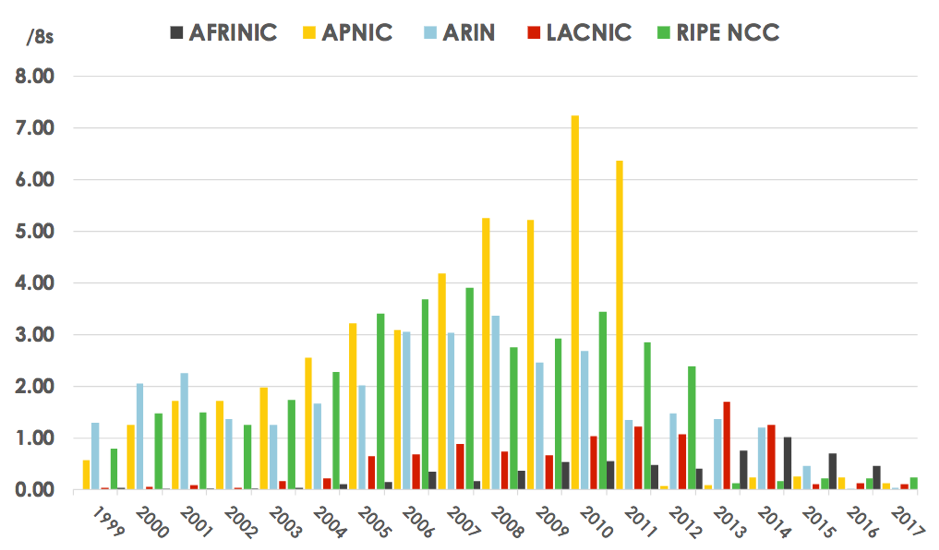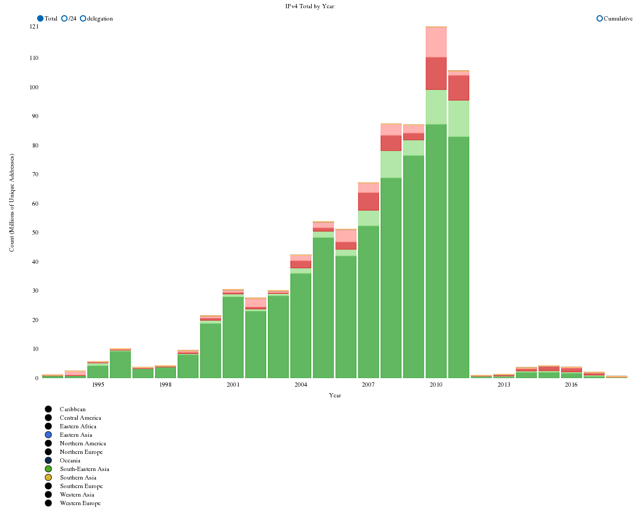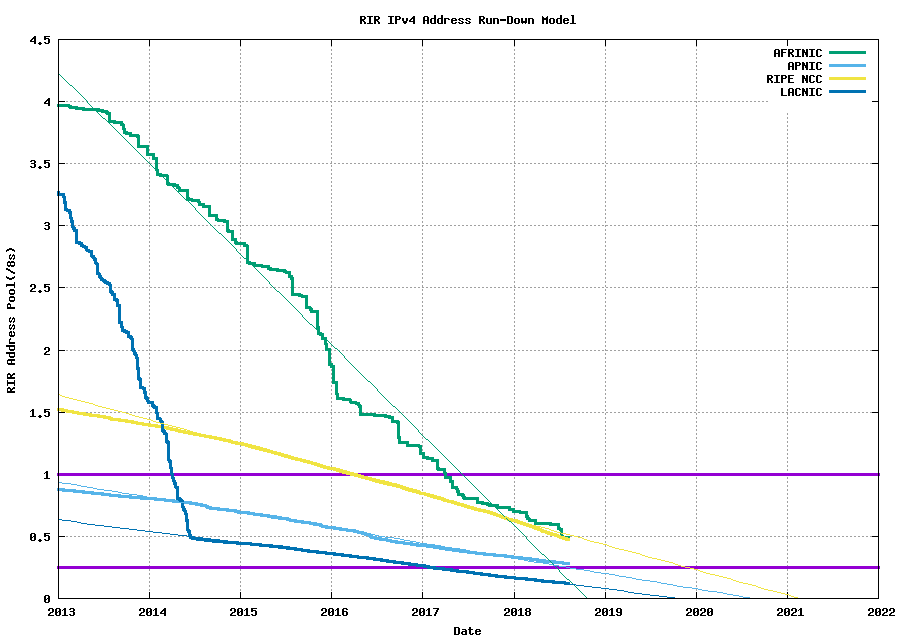
This is the second post in our series, investigating how number resource policies changed the development and growth of Internet infrastructure in the APNIC region.
Imagine it’s 2012. You’re a young entrepreneur with an interest in computers, whose government has just relaxed its telecommunication and trade regulations in a bid to tap into global markets.
You recognize that local businesses will need websites to sell their products overseas, so decide to set up a local hosting and data centre service. You’ll need IP addresses for your network and servers. A quick search points you to your Regional Internet Registry, where you click ‘get IP addresses’ and are confronted with only one option — IPv6.
What you’ll come to learn is that:
- Less than 1% of websites are connecting to Google via IPv6 at the time (a figure that has now exceeded 20%);
- IPv4-only networks and IPv6-only networks cannot communicate with each other unless translation is used. The only alternative is for all networks to run dual-stack, which is the preferred option as of now; and
- To run dual stack, network operators need both IPv4 and IPv6 addresses.
Something like this could have been a reality in the APNIC region if it weren’t for three wise engineers and a community that recognized the need to carefully support the transition to IPv6.
The mechanism was prop-062: Use of final /8, which specifies how APNIC allocates the last of its IPv4 addresses.
Avoiding a messy IPv4 depletion
Philip Smith was one of the three network engineers who wrote and submitted the proposal in July 2008. Prior to this, staff in the APNIC Secretariat and community members started asking the very important question ‘what happens when the IANA pool becomes exhausted?’.
 Figure 1 — IPv4 allocations to RIRs (1999-2017) (NRO 2017 Q4 report).
Figure 1 — IPv4 allocations to RIRs (1999-2017) (NRO 2017 Q4 report).

Figure 2 — IPv4 addresses allocated in the APNIC region (as of 1993) — notice the fall in 2012 after the last /8 was allocated by IANA in 2011.
“This predated the idea of the global policy, which specified that the last five /8s in the IANA pool would be equally delegated among the five RIRs when IANA had exhausted its IPv4 addresses,” says Philip.
“So, we were like ‘okay, there are about 35 or so /8s left in the IANA pool. The RIRs could burn through those in five years at the rate they are going, which only gives us two and a half years to implement a policy’. Let’s make it happen.”
With the help of Jonny Martin and Randy Bush, Philip submitted prop-062 and presented it at the APNIC 26 Policy SIG meeting in Christchurch, New Zealand, alongside the global policy.
“There was some robust discussion on the mailing list and at the meeting, particularly about the size of allocations that organizations would receive from APNIC’s last /8 pool,” says Philip.
“We had to explain why a /22 was an appropriate maximum allocation and not a /23 or /21 — the reason being is that it would give us 16,384 /22 allocations, which would accommodate APNIC’s current and future Member needs.”
Another point of contention with the first draft — even among the authors — was the provision that organizations that applied for a final IPv4 allocation were required to also deploy IPv6 in a certain timeframe.
“I remember Randy saying ‘Why do you need to specify that in the policy. It’s obvious that a /22 is a transition mechanism’. What he meant by this was you cannot set up nor sustain a large-scale network with only 1,024 addresses (/22), so if you want to grow, you’ll need to get and use IPv6,” Philip says.
“Taking out this provision definitely helped with reaching consensus.”
Philip would go on to submit the proposal at RIPE NCC meetings and suggest similar ideas to the other three RIRs. The RIPE NCC and AFRINIC implemented a similar proposal. ARIN and LACNIC implemented a policy where tiny assignments were assigned each time an organization asked for a chunk of addresses (they would go back to the end of the queue for every application).
Watching the prediction come true
Prop-062 was implemented in February 2009, specifying that APNIC would continue to allocate addresses on a ‘needs basis’, but once it got down to its final /8, all current and new Members were eligible to request and receive only one maximum allocation (/22).
In the following two years, Philip’s predictions about the remaining IPv4 space played out at more than double the speed expected, with the final /8s distributed to the five RIRs in February 2011.
The impact
Prop-062, or ‘the last /8 policy’ as it has become more commonly known, has had a positive influence on the development of the Internet in the Asia Pacific.
- Since April 2011 to date, more than 13,300 delegations of IPv4 to APNIC and National Internet Registry Members have been made under the policy. Many of those organizations would not have been able to receive IPv4 from APNIC if the policy did not exist.

Figure 3 — RIR IPv4 address run-down model (APNIC Labs).
- Internet innovation and growth has continued. Thousands of new ISPs, data centres, and Internet businesses have been created in the APNIC region since 2011, and a situation where incumbent network operators held all addresses with no room for new entrants has been largely avoided.
Welcome to our 5000 Member🎈
Bluewave Broadband Ltd, based in Myanmar. http://t.co/xYvKaIeXKG pic.twitter.com/E8IfslEMA4— APNIC (@apnic) September 23, 2015
- Emerging economies have benefitted in particular. The number of APNIC Members in Bangladesh, for example, has increased five-fold since 2011; in Myanmar, APNIC Member growth has been 5,500% over the same period. The policy assisted with cushioning the blow of IPv4 exhaustion and allowed startups to get addresses.

Figure 4 —Number of new APNIC Members from emerging economies (2006-2018).
Did the authors’ notion that a final /22 of IPv4 would act as a transition mechanism, and encourage operators to move to IPv6, come true?
On face value, it is hard to say it has — yet. The scarcity of IPv4 has seen the rise of Network Address Translation (NAT) and today’s Internet of 23 billion devices runs on 2.8 billion IPv4 addresses. However, IPv6 adoption continues to steadily increase.
Philip’s tips for becoming involved in the policy process
“Don’t try to do anything by yourself. Make the effort to find co-authors, plural, so at least two. And not just friends but other people in the industry who have a similar desire to make the Internet better; people who are passionate.
Also, do your homework. Don’t just jump on the policy list and say ‘Hey, I’ve got a great proposal’ – don’t even mention proposal in the beginning. Instead, start by describing the problem you’ve noticed and a possible solution or ‘What if’ you and others have been thinking of. What you’ll find is people on the list may say ‘You might like to try and do it this way’.
It may take two months or so, but you’ll find you will narrow down your idea to something that might work as a proposal and potentially even find your co-authors too. You will have also already generated interest in the topic and a sizeable amount of consensus, so when it comes to presenting it at a Policy SIG, you will have a fairly good idea of whether it will be accepted.”
The views expressed by the authors of this blog are their own and do not necessarily reflect the views of APNIC. Please note a Code of Conduct applies to this blog.
